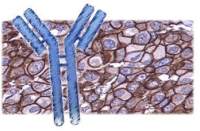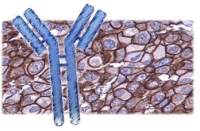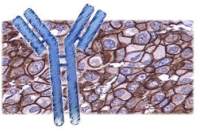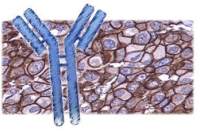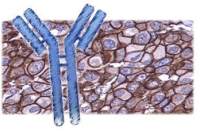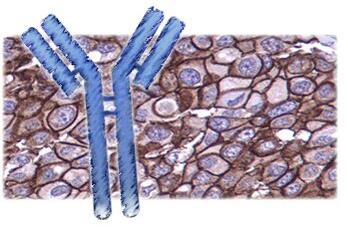
产品详情
文献和实验
相关推荐
供应商 :上海联迈生物工程有限公司
库存 :大量
靶点 :详见说明书
级别 :1
目录编号 :LM-5249R-FITC
克隆性 :多克隆
抗原来源 :Rabbit
保质期 :1年
抗体英文名 :Anti-Phospho-CDK9 (Thr29)/FITC
抗体名 :Anti-Phospho-CDK9 (Thr29)/FITC
标记物 :FITC标记
宿主 :Human, Mouse, Rat, Chicken, Dog, Pig, Cow,
适应物种 :Human, Mouse, Rat, Chicken, Dog, Pig, Cow,
免疫原 :详见说明书
亚型 :IGg
形态 :粉末、液体、冻干粉
应用范围 :IF=1:50-200
浓度 :1mg/ml
保存条件 :-20 °C
规格 :100ul
FITC标记的磷酸化周期素依赖性激酶9抗体| 英文名称 | Anti-Phospho-CDK9 (Thr29)/FITC |
| 中文名称 | FITC标记的磷酸化周期素依赖性激酶9抗体 |
| 别 名 | CDK9 (Phospho-Thr29); CDK9 (Phospho T29); C 2k; C-2K; CDC2 related kinase; CDC2L4; Cdk 9; Cdk9; CDK9_HUMAN; Cell division cycle 2 like protein kinase 4; Cell division cycle 2-like protein kinase 4; Cell division protein kinase 9; CTK1; Cyclin dependent kinase 9; Cyclin-dependent kinase 9; PITALRE; Serine threonine protein kinase PITALRE; Serine/threonine-protein kinase PITALRE; TAK; Tat associated kinase complex catalytic subunit. |
| 规格价格 | 100ul/2980元 购买 大包装/询价 |
| 说 明 书 | 100ul |
| 产品类型 | 磷酸化抗体 |
| 研究领域 | 免疫学 染色质和核信号 神经生物学 细胞凋亡 细胞周期蛋白 激酶和磷酸酶 |
| 抗体来源 | Rabbit |
| 克隆类型 | Polyclonal |
| 交叉反应 | Human, Mouse, Rat, Chicken, Dog, Pig, Cow, |
| 产品应用 | IF=1:50-200 not yet tested in other applications. optimal dilutions/concentrations should be determined by the end user. |
| 分 子 量 | 43kDa |
| 性 状 | Lyophilized or Liquid |
| 浓 度 | 1mg/ml |
| 免 疫 原 | KLH conjugated Synthesised phosphopeptide derived from human CDK9 around the phosphorylation site of Thr29 |
| 亚 型 | IgG |
| 纯化方法 | affinity purified by Protein A |
| 储 存 液 | 0.01M TBS(pH7.4) with 1% BSA, 0.03% Proclin300 and 50% Glycerol. |
| 保存条件 | Store at -20 °C for one year. Avoid repeated freeze/thaw cycles. The lyophilized antibody is stable at room temperature for at least one month and for greater than a year when kept at -20°C. When reconstituted in sterile pH 7.4 0.01M PBS or diluent of antibody the antibody is stable for at least two weeks at 2-4 °C. |
| 产品介绍 | background: The protein encoded by this gene belongs to the highly conserved cyclin family, whose members are characterized by a dramatic periodicity in protein abundance through the cell cycle. Cyclins function as regulators of CDK kinases. Different cyclins exhibit distinct expression and degradation patterns which contribute to the temporal coordination of each mitotic event. This cyclin tightly associates with CDK9 kinase, and was found to be a major subunit of the transcription elongation factor p-TEFb. The kinase complex containing this cyclin and the elongation factor can interact with, and act as a cofactor of human immunodeficiency virus type 1 (HIV-1) Tat protein, and was shown to be both necessary and sufficient for full activation of viral transcription. This cyclin and its kinase partner were also found to be involved in the phosphorylation and regulation of the carboxy-terminal domain (CTD) of the largest RNA polymerase II subunit. Function: Protein kinase involved in the regulation of transcription. Member of the cyclin-dependent kinase pair (CDK9/cyclin-T) complex, also called positive transcription elongation factor b (P-TEFb), which facilitates the transition from abortive to productive elongation by phosphorylating the CTD (C-terminal domain) of the large subunit of RNA polymerase II (RNAP II) POLR2A, SUPT5H and RDBP. This complex is inactive when in the 7SK snRNP complex form. Phosphorylates EP300, MYOD1, RPB1/POLR2A and AR, and the negative elongation factors DSIF and NELF. Regulates cytokine inducible transcription networks by facilitating promoter recognition of target transcription factors (e.g. TNF-inducible RELA/p65 activation and IL-6-inducible STAT3 signaling). Promotes RNA synthesis in genetic programs for cell growth, differentiation and viral pathogenesis. P-TEFb is also involved in cotranscriptional histone modification, mRNA processing and mRNA export. Modulates a complex network of chromatin modifications including histone H2B monoubiquitination (H2Bub1), H3 lysine 4 trimethylation (H3K4me3) and H3K36me3; integrates phosphorylation during transcription with chromatin modifications to control co-transcriptional histone mRNA processing. The CDK9/cyclin-K complex has also a kinase activity towards CTD of RNAP II and can substitute for CDK9/cyclin-T P-TEFb in vitro. Replication stress response protein; the CDK9/cyclin-K complex is required for genome integrity maintenance, by promoting cell cycle recovery from replication arrest and limiting single-stranded DNA amount in response to replication stress, thus reducing the breakdown of stalled replication forks and avoiding DNA damage. In addition, probable function in DNA repair of isoform 2 via interaction with KU70/XRCC6. Promotes cardiac myocyte enlargement. RPB1/POLR2A phosphorylation on 'Ser-2' in CTD activates transcription. AR phosphorylation modulates AR transcription factor promoter selectivity and cell growth. DSIF and NELF phosphorylation promotes transcription by inhibiting their negative effect. The phosphorylation of MYOD1 enhances its transcriptional activity and thus promotes muscle differentiation. Subunit: Associates with CCNT1/cyclin-T1, CCNT2/cyclin-T2 (isoform A and isoform B) or CCNK/cyclin-K to form active P-TEFb. P-TEFb forms a complex with AFF4/AF5Q31. Component of a complex which is composed of at least 5 members: HTATSF1/Tat-SF1, P-TEFb complex, RNA pol II, SUPT5H, and NCL/nucleolin. Associates with UBR5 and forms a transcription regulatory complex composed of CDK9, RNAP II, UBR5 and TFIIS/TCEA1 that can stimulate target gene transcription (e.g. gamma fibrinogen/FGG) by recruiting their promoters. Component of the 7SK snRNP inactive complex which is composed of at least 8 members: P-TEFb (composed of CDK9 and CCNT1/cyclin-T1), HEXIM1, HEXIM2, LARP7, BCDIN3, SART3 proteins and 7SK and U6 snRNAs. This inactive 7SK snRNP complex can also interact with NCOR1 and HDAC3, probably to regulate CDK9 acetylation. Release of P-TEFb from P-TEFb/7SK snRNP complex requires both PP2B to transduce calcium Ca(2+) signaling in response to stimuli (e.g. UV or hexamethylene bisacetamide (HMBA)), and PPP1CA to dephosphorylate Thr-186. This released P-TEFb remains inactive in the preinitiation complex with BRD4 until new Thr-186 phosphorylation occurs after the synthesis of a short RNA. Binds to BRD4, probably to target chromatin binding. Interacts with the acidic/proline-rich region of HIV-1 and HIV-2 Tat via T-loop region, and is thus required for HIV to hijack host transcription machinery during its replication through cooperative binding to viral TAR RNA. Interacts with activated nuclear STAT3 and RELA/p65. Binds to AR and MYOD1. Forms a complex composed of CDK9, CCNT1/cyclin-T1, EP300 and GATA4 that stimulates hypertrophy in cardiomyocytes. Isoform 3 binds to KU70/XRCC6. Subcellular Location: Nucleus. Cytoplasm. Nucleus, PML body. Note=Accumulates on chromatin in response to replication stress. Complexed with CCNT1 in nuclear speckles, but uncomplexed form in the cytoplasm. The translocation from nucleus to cytoplasm is XPO1/CRM1-dependent. Associates with PML body when acetylated. Tissue Specificity: Ubiquitous. Post-translational modifications: Autophosphorylation at Thr-186, Ser-347, Thr-350, Ser-353, Thr-354 and Ser-357 triggers kinase activity by promoting cyclin and substrate binding (e.g. HIV TAT) upon conformational changes. Thr-186 phosphorylation requires the calcium Ca(2+) signaling pathway, including CaMK1D and calmodulin. This inhibition is relieved by Thr-29 dephosphorylation. However, phosphorylation at Thr-29 is inhibitory within the HIV transcription initiation complex. Phosphorylation at Ser-175 inhibits kinase activity. Can be phosphorylated on either Thr-362 or Thr-363 but not on both simultaneously (PubMed:18566585). Dephosphorylation of Thr-186 by PPM1A and PPM1B blocks CDK9 activity and may lead to CDK9 proteasomal degradation. However, PPP1CA-mediated Thr-186 dephosphorylation is required to release P-TEFb from its inactive P-TEFb/7SK snRNP complex. Dephosphorylation of C-terminus Thr and Ser residues by protein phosphatase-1 (PP1) triggers CDK9 activity, contributing to the activation of HIV-1 transcription. N6-acetylation of Lys-44 by CBP/p300 promotes kinase activity, whereas acetylation of both Lys-44 and Lys-48 mediated by PCAF/KAT2B and GCN5/KAT2A reduces kinase activity. The acetylated form associates with PML bodies in the nuclear matrix and with the transcriptionally silent HIV-1 genome; deacetylated upon transcription stimulation. Polyubiquitinated and thus activated by UBR5. This ubiquitination is promoted by TFIIS/TCEA1 and favors 'Ser-2' phosphorylation of RPB1/POLR2A CTD. DISEASE: Note=Chronic activation of CDK9 causes cardiac myocyte enlargement leading to cardiac hypertrophy, and confers predisposition to heart failure. Similarity: Belongs to the protein kinase superfamily. CMGC Ser/Thr protein kinase family. CDC2/CDKX subfamily. Contains 1 protein kinase domain. Database links: Entrez Gene: 1025 Human Entrez Gene: 107951 Mouse Entrez Gene: 362110 Rat Omim: 603251 Human SwissProt: P50750 Human SwissProt: Q99J95 Mouse SwissProt: Q641Z4 Rat Unigene: 150423 Human Unigene: 706809 Human Unigene: 27557 Mouse Unigene: 98228 Rat Important Note: This product as supplied is intended for research use only, not for use in human, therapeutic or diagnostic applications. Cdk9-周期素依赖激酶9(Cyclin Dependent Kinase 9),同样是参与细胞周期的调控,在细胞分化、有丝分裂中起重要作用。 |

上海联迈生物工程有限公司
品牌商实名认证
钻石会员
入驻年限:8年

